Real-Time Scheduling on Multicore Platforms1
Introduction
Thermal and power problems limit the performance that singleprocessor chips can deliver. Multicore architectures, or chip multiprocessors, which include several processors on a single chip, are being widely touted as a solution to this problem.
In many proposed multicore platforms, different cores share either on- or off-chip caches. To effectively exploit the available parallelism on these platforms, shared caches must not become performance bottlenecks.
论文焦点是“多核平台上实时应用的调度”。在该论文中,作者将关注的多核体系结构限制为如下模型:
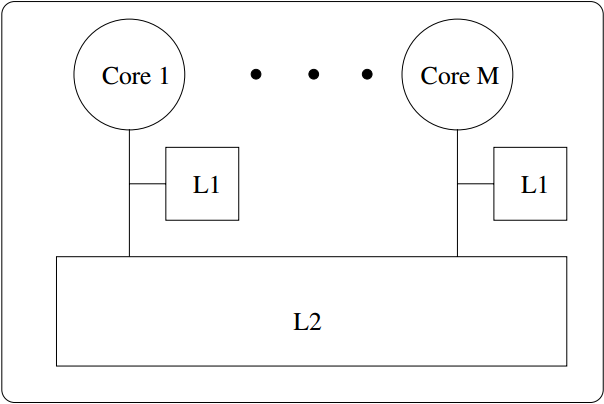
注意:L2 misses对性能的影响远大于L1 misses。这是因为处理L2 miss(需要访问内存)可能需要高达100-300 cycles,而处理L1 miss(通过访问L2)则只需要10-30 cycles。2
所研究的问题
Wishing to know whether, in realtime systems, tasks that generate significant memory-to-L2 traffic can be discouraged from being co-scheduled while ensuring real-time constraints.所提出的方法
Two-step process:
(1) combine tasks that may induce significant memory-to-L2 traffic into groups;
(2) at runtime, use a scheduling policy that reduces concurrency within groups.Megatask
基于组识别的调度策略是一个基于megatask(巨型任务)概念的分层调度方法。一个megatask 表示为一个任务组,其被当作一个单一调度实体。上层的调度器给一个megatask分配一个或多个处理器,megatask再轮流将处理器分配给它的组件任务。假设γ是一个 megatask,其组件任务的总利用率(处理器利用率)是I + f,其中I是整数部分,f是小数部分( 0 < f < 1)。这样组件任务需要I到I+1个处理器以满足它们的deadline。在论文中,为避免L2 cache发生抖动(thrashing),在γ中至多可以并发调度(co-scheduled)I+1个任务。例子
Consider a four-core system in which the objective is to ensure that the combined working-set size of the tasks that are co-scheduled does not exceed the capacity of the L2 cache. Let the task set τ be comprised of three tasks of weight (i.e., utilization) 0.6 and with a working-set size of 200 KB (Group A), and four tasks of weight 0.3 and with a working-set size of 50 KB (Group B). Let the capacity of the L2 cache be 512 KB. The total weight of τ is 3(3*0.6+4*0.3), so co-scheduling at least three of its tasks is unavoidable. However, since the combined working-set size of the tasks in Group A exceeds the L2 capacity(3*200>512), it is desirable that the three co-scheduled tasks not all be from this group. Because the total utilization of Group A is 1.8, by combining the tasks in Group A into a single megatask, it can be ensured that at most two tasks from it are ever co-scheduled.
Pfair Scheduling
Pfair scheduling can be used to schedule a periodic,
intra-sporadic (IS), or generalized-intra-sporadic (GIS) task system τ on M ≥ 1 processors. Each task T
of τ is assigned a rational weight wt(T) ∈ (0, 1] that denotes the processor share it requires. For a periodic task T ,
wt(T) = T.e/T.p, where T.e and T.p are the (integral) execution cost and period of T . A task is light if its weight is less
than 1/2, and heavy, otherwise.
Pfair algorithms allocate processor time in discrete quanta;
the time interval [t, t + 1), where t ∈ N (the set of nonnegative integers), is called slot t.
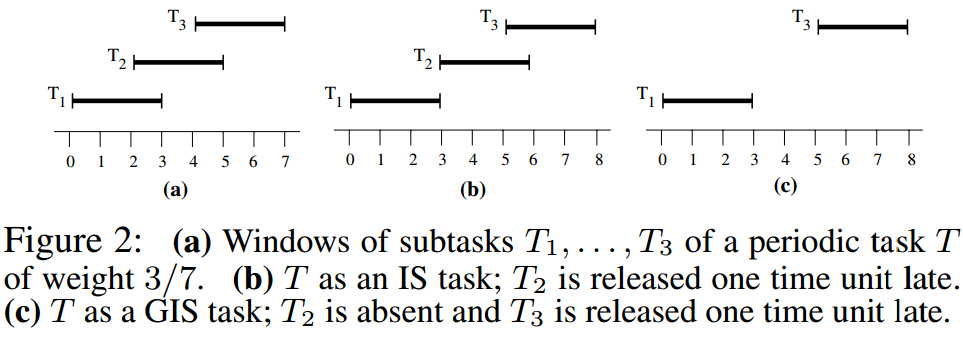
注意:周期性任务系统也是IS任务系统,进而也是GIS任务系统,所以构建出适合GIS任务的模型也适合于其他任务模型。
- 调度算法
- Pfair scheduling算法的调度原则:earliest-deadline-first。
- 以防两个子任务出现相同的deadline,需要使用Tie-breaking rules。
- 所知的最有效的最优算法是PD2,它使用两个tie-breaks。
- PD2 is optimal,it correctly schedules any GIS task system τ for which T ∈τ wt(T ) ≤ M holds.
- 需要注意:即使使用最优的PD2算法作为第二层调度器,组件任务的deadline也可能得不到保证,为此作者提出了两种方法:1)Reweighting a megatask;2)Tardiness bounds without reweighting。
(上述两种方法全是理论证明和理论公式,在此就不详细介绍。)
Experimental Results
为了获取megatasking在减少cache竞争的效率,作者使用SESC模拟器进行了实验。
- 所模拟的体系结构由不同数量的核组成,每一个均拥有16K L1 data and instruction caches (4- and 2-way set associative, respectively) with random and LRU replacement policies, respectively, and a shared 8-way set associative 512K on-chip L2 cache with an LRU replacement policy。
- 每一个cache拥有一个 64-byte line size。
- 在一个给定的working-set size(WSS)下,每一个调度任务均被赋予一个utilization and memory block。 任务是顺序访问内存块的,且访问到末尾时会再次回到开始处。
- 所有的调度、抢占、迁移开销均在模拟中被考虑进去。
下面是作者在两种任务集上进行了模拟实验。在两个实验中,均将Pfair scheduling with megatasks 与 partitioned3 EDF and ordinary Pfair scheduling (without megatasks)进行了比较。
Hand-Crafted Task Sets
- 所产生的hand-crafted task sets如下:

备注:1 quanta = 1 ms.
- 模拟运行结果如下:
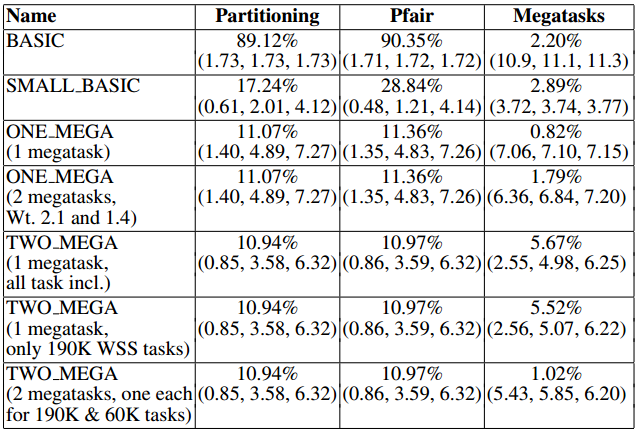
在获得这些结果时,megatask并没有进行reweighted,因为此处更关注cache的行为而不是时间属性。
- BASIC由三个heavy-weight任务组成,运行其中两个不会产生L2 cache抖动,但是运行三个会产生。Partitioning 和 Pfair调度算法使用超过了2个核,产生了抖动,而将所有的任务并进一个megatask中,每次调度最多只会调度2(3*0.6=1.8,1+1=2)个任务,抖动消失。这个在BASIC中表现的十分明显。
- SMALL_BASIC的效果与BASIC相同,但是表现的不如BASIC明显。
- 将ONE_MEGA视为一个megatask时,一次最多可以调度4(5*0.7=3.5,3+1=4)个任务,不会产生抖动;而将ONE_MEGA视为2个megatask(2.1和1.4)可能会出现一次调度5(2.1->3,1.4->2,3+2)个任务的情况。
- 将TWO_MEGA的整体视为一个megatask,可以保证最多一次调度4个任务,但是可能调用的包含三个WSS 190K的任务,这样便会产生L2 cache抖动;若仅仅只是将WSS 190K的三个任务视为一个megatask,三个WSS 60K的任务作为 free task,情况会仅仅好一些(因为会出现 190*2+60*3=560>512的情况)。然而将TWO_MEGA分成两个 megatasks, one eachfor 190K & 60K tasks,这样最多只会出现2个WSS 190K和2个WSS 60K的任务共同被调度,不会产生L2 cache抖动(190*2+60*2=500<512)。
- 从相同时间内(从某一行看),每个任务完成的内存访问数来看,megatask的运行结果十分优越。
- 解释:For example,the number of memory accesses (in millions) for the tasks in SMALL BASIC was {0.614, 4.123, 0.613, 4.103, 0.613} under partitioning, but {3.755, 3.765, 3.743, 3.717, 3.723} for megatasking.这样的非均匀的分布导致,在某些案例下,partioning拥有更高的最大完成内存访问数的值。
Randomly-Generated Task Sets
- In generating task sets at random, the authors limited attention to a four-core system, and considered total WSSs of 768K, 896K, and 1024K, which correspond to 1.5, 1.75, and 2.0 times the size of the L2 cache.
- Total system utilizations were allowed to range between 2.0 and 3.5.
- Task utilizations were generated uniformly over a range from some specified minimum to one, exclusive. The minimum task utilization was varied from 1/10 (which makes finding a feasible partitioning easier) to 1/2 (which makes partitioning harder).
- In total, 552 task sets were generated.
- 产生这些任务集之后需要进行包装:
- 对于partitioning,注意使用首次适用策略(使用两次,第一次的标准依据WSS递减,第二次的标准依据是利用率递减,第一次失败则使用第二次);
- 对于megatask,详细见论文,具体原则是“If the current task could be added to the current megatask without pushing the megatask’s weight beyond the next integer boundary,then pack it to one.”。
- 上述两种包装均会产生不合格的任务,不合格任务在实验时将不被包含。
- 在产生megatasks之后,每个megatask将被reweighted。
Randomly-Generated Task Sets运行结果
L2 cache miss rates数据分析如下:
使用三种调度算法,每一个合格的任务将被执行20 quanta,记录L2 cache miss rate。
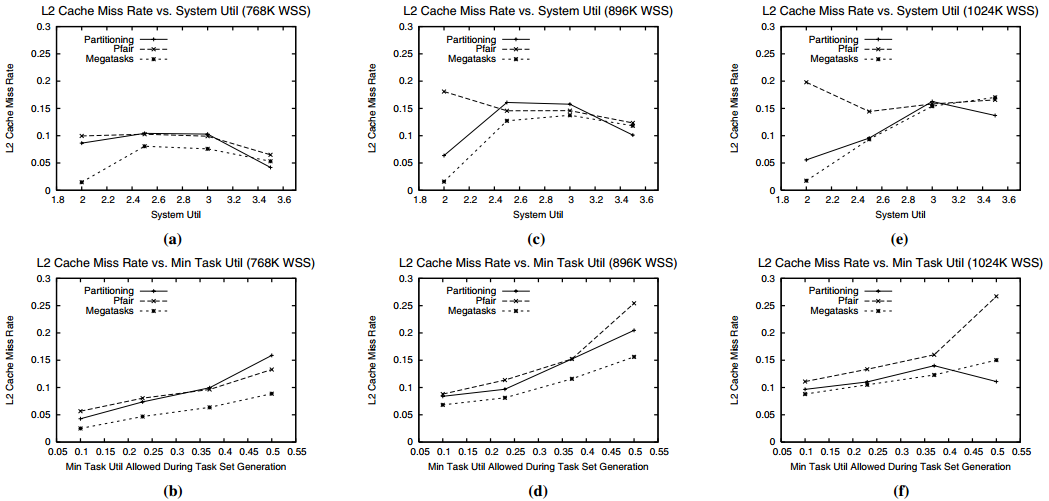
注意:较小的L2 cache miss rate不同将会导致很大的性能不同。下图给出了对于图(b)的 cycles-permemory-reference的数量.
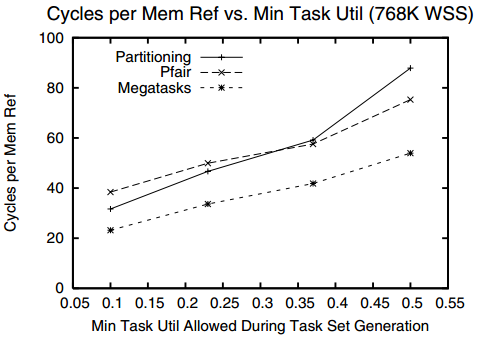
- As seen in the bottom-row plots, the L2 miss rate increases with increasing task utilizations.这是因为heaviest tasks拥有最大的WSSs,因此很难在较少的核上运行。
- The top-row plots show a similar trend as the total system utilization increases from 2.0 to 2.5.
- 在总系统利用率超过2.5之后,miss rate 开始下降。一个可能的解释: The task-generation process may leave little room to improve miss rates at total utilizations beyond 2.5.
- 对于总的WSS来说,在1.5倍L2 cache大小下,megatask表现最好,且明显。 在1.75倍、2倍L2 cache大小下,megatask在大多数情况下表现仍然最好,但是不明显。这是因为在1.75倍、2倍L2 cache大小下,这三种调度模式都不能很好的改善L2 cache性能,这在2倍L2 cache大小下体现尤为明显。
内存访问统计数据(数据不包括调度代码本身)如下:

- Megatasking is the clear winner by 5-6% on average and by as much as 30% in the worst case (as seen by the minimum values).
下周任务
- 继续阅读与SESC模拟器相关的论文
- 继续学习SESC的使用及部分核心源码的阅读
Anderson J H, Calandrino J M, Devi U M C. Real-time scheduling on multicore platforms[C]//Real-Time and Embedded Technology and Applications Symposium, 2006. Proceedings of the 12th IEEE. IEEE, 2006: 179-190.↩
A. Fedorova, M. Seltzer, C. Small, and D. Nussbaum. Performance of multithreaded chip multiprocessors and implications for operating system design. Proc. of the USENIX 2005 Annual Technical Conf., 2005. (See also Technical Report TR-17-04, Div. of Engineering and Applied Sciences, Harvard Univ. Aug., 2004.)↩
A cache-partitioning scheme is presented that uniformly distributes the impact of cache contention among co-scheduled threads.↩